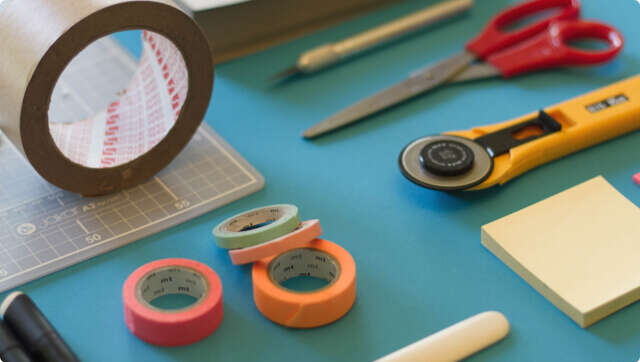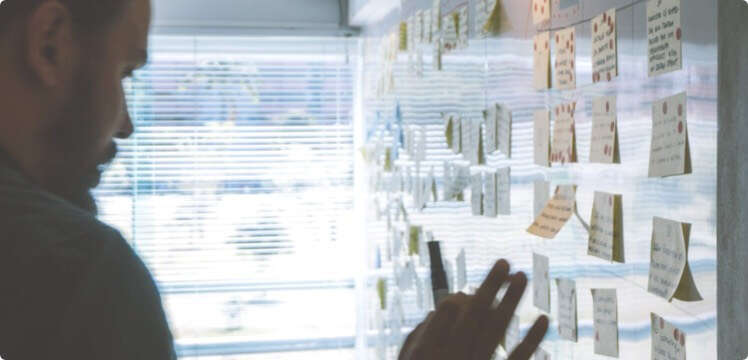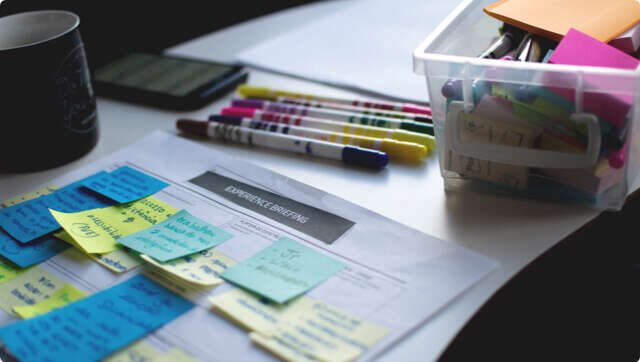Run design sprints with interdisciplinary teams: Our Design Sprint 101s
Digital technologies that cover basic or fundamental human needs have matured so much that their diffusion crosses 80% of the population in many countries. Alas, competition in the marketplace, in B2C or B2B, continues to heat up across practically all industries.
No time to read a full book about design sprints? See our 101s below.
There is a plethora of reasons for why projects don’t turn out to be as great as was initially thought. Building the right product to win in the marketplace is hard. It has to be. If it would be simple, competition would be so fierce that few companies would see a decent return on their investment.

Luckily there are methodologies that improve, speed up or shorten the way to launch successful products the market wants. The design sprint is such a methodology.
Which Design Sprint 101 is for me?
Pick your favorite:
The CEO Design Sprint 101
So, your team wants to run a design sprint and involve you for more than just an hour or two. Well, are you convinced that the sprint will help your team and your company? If yes, jump to the next section. If not, this is for you–continue here.
Why do they want to run a sprint and spent five consecutive days?
Well, the design sprint has gotten very popular, in part, because the format originated at Google. Google is a successful company, so, other companies (especially those that are not so successful) want to imitate the big guys. There is nothing wrong with that, since in the end, things that work, evolve. Things that don’t work, will falter. Apparently, the design sprint works.
Furthermore, if you have seen or heard about a similar method, called design thinking, before, a design sprint is similar. Now, design thinking, typically, focuses on (user) research, discovery and learning more than it does on execution of what was uncovered by such research. Not a design sprint. However, the design sprint is to a large extend old content in a new package. But this new package does certainly have value. So, don’t brush it off just yet.
The design sprint offers both, research and execution, in a very concise, collaborative and compact format with real user input - typically five days from start to finish. The timeframe can be shortened or lengthened (to some extend).
Less time to spend? That does sound like great news, doesn’t it? The cycles’ length can be adjusted to the needs of your company, and availability but, mind you: The format originated as is because five days really work best. Hence, changes to the timeframe have their disadvantages.
What about other benefits for us?
Well, as you may know from your own company, many companies don’t do enough ethnographic (user) research or user testing. Why? Because it’s easy not to do it. Further, don’t we all think that we already know a lot about the topic/product or business at hand? So what gives. A design sprint allows half a dozen of your people to do hands-on, dirt cheap, user research in just 1-2 days. On the other hand, imagine you give your OK for some grandiose user research to some outside agency for execution.
Which initiative will take less time and is less costly? There you go. Your team also gets the added benefit of being exposed to the learnings themselves. All knowledge and learnings will remain in your company.
Last but not least, such a initiative has the potential to reduce resource investment for exploration of ideas and concepts.
But what about metrics?
You care about metrics and would ideally like to measure any design initiative as well. Design sprints often validate or invalidate ideas quickly, cheaply and early in the process.

Therefore, a good way to measure such initiatives is the ratio of ideas validated (or invalidated) to ideas generated. A great aspect about design sprints is that your core team decides on the best idea and executes on it quickly. How often does your company execute, test and explore the ideas generated with real users?
In Zone To Win Geoffrey Moore writes that a company only has to catch one major product category in a decade in order to spur growth. Let’s do the numbers with these assumptions:
- 1 design sprint / month: 12 sprints / year
- 5 good ideas generated / sprint: 5 x 12 = 60 / year
- 1 great idea / sprint (1 out of 5) pursued, executed and tested: 1 x 12 = 12 / year
- 20% of those great ideas get positively validated: ~2.5 / year
If you would take Geoffrey Moore’s advise to heart, your company would only need to go with 1 stellar idea out of 25 great ideas. Though, why not 2 out 25? It's likely that you don't achieve 25 hugely successful businesses out of these 25 great ideas per decade. We do the numbers: if we would take the "market's experience" and assume that roughly 95% of companies go bankrupt after 5-10 years, your company could still have 25 x 5% = 1.25 successful products or businesses per decade. This also almost equals Geoffrey Moore's 1 idea per decade. Coincidence?
Not too shabby, is it?
Want to give your team a GO and make sure they get up to speed from the get-go? Partner with us!
Facilitator 101
We assume you or your team have already decided to run a design sprint. And, they have decided that you will be the faciliator. Great! This 101 is for you to execute a successful sprint. It won’t tell you why do a sprint but what and how to do it, as well as and sometimes more importantly, what not to do.
Projects last as long as there is time for them to last: Deliberate tension across the sprint days will lead to the best results, e.g. a clear start and finish for each day and time-boxed exercises get the team engaged and excited.
Let’s get started.
What phases do I need to prepare for?
- Understand: Understand, define and explore
- Diverge: Generate ideas
- Converge: Decide and discard
- Prototype: Build to play
- Test: Validate like crazy
When to use the designs print format
- to reduce risk of failure on a risky project
- to gain speed, efficiency and focus
- to force the team to make decisions in regard to direction of a product or bigger feature
- to align a diverse team
- set up an initial, early process for a new team
- to validate more ideas, more quickly
When not to use the designs print format. When…
- the project requires a more fundamental research phrase which is beyond the scope of 1-2 days
- a project isn’t much longer than a few days
- a project is already well-defined
- the team does not see any value in a design sprint because e.g. business opportunity is not a given, the outcome won’t be within the strategy of the company or similar
5 days? It could be shorter or longer?
It is possible to reduce the time from five to three because full team only needs to be present for the Understand, Diverge and Converge phases. Prototyping and testing can be handled by a smaller set of people as the testing sessions can also be recorded. Any subtle modification from 7 hours a day to 5-6 is possible but we don’t recommend to go below 5. Also, extending to 8 or 9 hours because the team wants wrap up the sprint in 4 instead of 5 days is not recommended.

Preparation: Before the sprint
As they say, “failing to plan is planning to fail”.
Preparation isn’t everything but it almost guarantees a smooth ride across the 5 days of the sprint. Though, don’t be too German in your planning and execution and allow for flexibility.
T-3 Weeks before the sprint
Who’s the team? In smaller companies that may be super clear, in bigger ones it may not. Touch base with colleagues across the organisation to determine who can contribute to the sprint outcome best. Any person should have skin in the game to achieve the best outcome.
Participants could be:
- Designer
- Engineer or developer
- Product Manager
- Customer Service representative
- Sales person
- Markting Manager
- CEO / Founder
In a client / customer relationship, the client should of course join the sprint.
Build an agenda: Prepare the objectives for each phase, set a clear agenda and add exercises as well as time-boxes for each
Send the agenda: Send it to the entire team (a few days before the sprint start
Prepare a backup: If you have not run many sprints yet, it might be helpful to also prepare a backup plan with exercises (if you love momentum)
Set the scope: Don’t so this alone. Ask your sprint team members for help on this. What’s the expectation and goal for the sprint. Don’t set it too broad, nor too narrow.
Most importantly to kick off early: Reach out to potential candidates for the Monday interviews.
Interview candidates
Decide whether you need to set up Discovery interviews ahead of the sprint. Do not invite the same interview candidates for Monday, the first day of the sprint. Research, reach out and invite 6-7 seven users or customers for Monday. Each interview shall last been 30-45 mins. If you happen to not find 6-7, reduce the number and increase the interview duration.
T-2 week before the sprint
Time for supplies!
- Whiteboards
- Drawing markers: black works best
- Post-it notes: In any colour that provides enough contrast with ballpoints or sharpies. Get super-sticky notes in squared and rectangular size
- Whiteboard markers Black and one colour, e.g. red
- Dot stickers: Use them for voting. You want something small with a few colors. Red/yellow/green are recommended.
- Adhesive putty: To stick things to the walls or windows.
- A4 blank copy paper: Get the 120 or 140 grams-type paper
- Snacks: Good food is better than just junk, but of course, some sugar will help
- Coffee: Coffee helps indeed. For those, who don’t like coffee get RedBull
- Easel pads: Ideally you get a workshop room with IdeaPaint but those do work as well And…
A time timer! You can surely use a mobile phone for that purpose but we believe the time timer is way, way better as everyone can see the available minutes, at any time, from anywhere in the workshop room.

The technical “challenge”: If you happen to work in a bigger company, your company will surely have a working beamer setup with all necessary cables and adapters. If you happen to move around between company, big and small, it might be helpful to have an assorted set of these cables and adapters, e.g. HDMI, DVI, VGA, Thunderbolt and a mix of various from-to between these hardware interfaces.
Background or research material
Ask your team ahead of time for any material that might help the sprint succeed. This could be a list of apps, sites, PDFs, similar products, pitch decks, wireframes, user stories and the like. Organise whatever your team sends you and make it accessible to the team a couple of days before the sprint starts. We recommend only a “couple of days”. If there is too much time between send-out and sprint, the team might either review it way ahead of time and then forget about details, or they simply forget to review the material.
T-1 week
Get a space and set it up
- Keep the same space for the entire length of the sprint. It’s not much fun to prepare a new space every other day, e.g. moving around whiteboards and making sure all post-its survive the move
- We are not a fan of remote design sprints as on-site sessions result in more productive engagements by each and every participant. We have seen remote ones slip due to “small issues” like time zone difference.
Supplies: All supplies ready? If not, see the list above.
It's sprint time
Your responsibility as the faciliator will center around taking care of your team with breaks, water and food. Help the team when they are stuck, ask Why at all times and always be capturing what your team produces.
Understand (Monday, 1st day)
- Introductions, review design sprint rules: ~3 hours
- Define the problem: ~1 hour
- Get to know the user or customer: ~3 hours
Keep in mind that a design sprint is a flexible setup. You can add, reorder, skip, shorten or extend but remain sensitive to the time constraints - these are very important.
Introductions and review
- Allow all participants to get to know each other
- Review the rules for the design sprint (remember, constraints make your team more creative)
- Review whatever material about the project (slides, wireframes etc) you were able to gather
- Goals and anti-goals: Get optimistic and then pessimistic
- Reviews, discuss existing product, competitors, and substitutes
- Facts and assumptions: Have the team put all assumptions and biases on the table
The user or customer
- Who/Do: Stakeholders, users, customers, whom does the service touch
- Personas:
- Discovery Interviews: This you already have down before the start of the sprint or will do now
- User Journey Map: Before, during and after
The Problem
- Problem statement: Clarify what the real problem at hand is, set the right boundaries and restrictions
- Reframe the problem with challenge maps: How might be? Reframe the problem
Diverge (Tuesday, 2nd day)
Your job
- Guide the team
- Capture as much as possible
- Check-in with the interview participants for Friday
Agenda for your team
- Start off: ~60 mins
- Generate solutions with the Four-Step-Sketch: Rest of day
- Repeat (optional)
Start off
- Review sprint rules: See Monday
- Pitch practice: See Monday
- Background phase recap
Be creative
- Mind maps
- Crazy Eights
- Storyboard
- Silent Critique
- Group Critique
- Super Vote

Converge (Wednesday, 3rd day)
Your job: Guide the team and capture as much as possible. Interviews set for Friday?
- Start off: ~10 mins
- Scrutinize your work: ~2.5 hours
- Wireframe the prototype: 1.5 hours
Start off
- Explain the purpose of that day
- Pitch practice yet again
Scrutinize your work
- Recap Background
- Review Assumptions
- $100 Test/Risks
- Identify alternatives
- 2x2 Matrix
Wireframe the prototype
- Team sketching
- Ritual dissent
- Team sketching
- Ritual dissent
- Final sketch
Prototype (Thursday, 4th day)
Your job: Guide the team and capture as much as possible. Interviews set for Friday?
- Remind participants about their user testing session tomorrow
- Go and build the prototype
- Define the test plan
- Trial run the prototype before the day ends!
Define the test plan
- Assumptions and validation board: Prioritize assumptions and determine what the prototype shall validate
- Pre-roll questions: Anything your team may ask before each participant tests the prototype
- Post-roll questions: To wrap app the session, ask the customer or user a few final questions
Build the prototype
Use the teams expertise to craft a prototype that is not too complex but also not too simple. Be aware that “nerdy prototypes” typically take longer than expected. Take a look at ht assumptions and goals for the sprint, review, discuss and define what shall be build.
Testing (Friday, last day)
From 09:00 to 15:00, your team will interview one participant for about 45-50 mins each. Check in with your team for when they want to have have lunch in between.
Debrief after the last interview and discuss next steps.
Want to give your team a GO and make sure they get up to speed from the get-go? Partner with us!
Want to come up with a new digital product, expand your existing business, stay competitive? What's your next step?
Get in touch with Andree Huk
at +49 30 5557 7174 or [email protected].